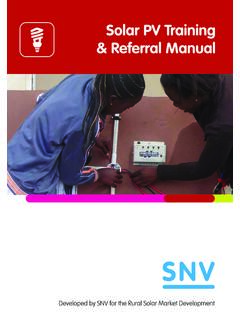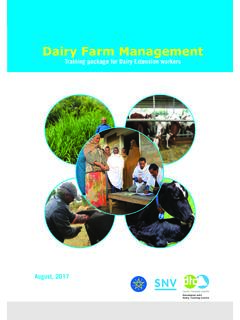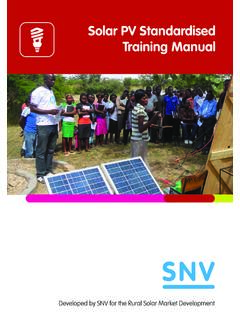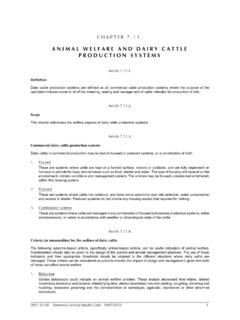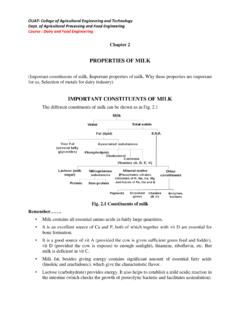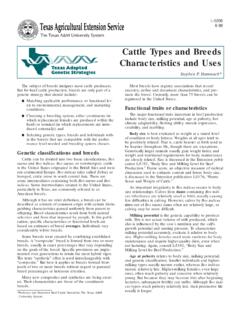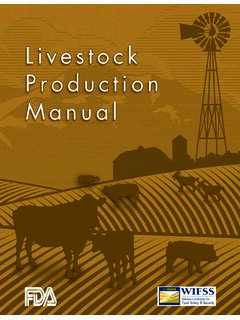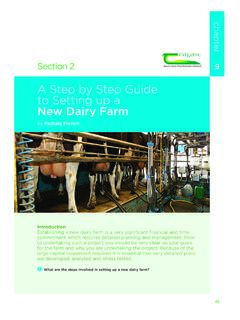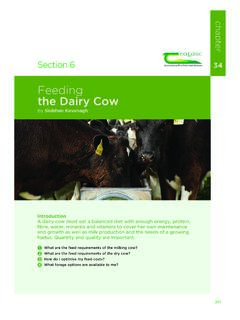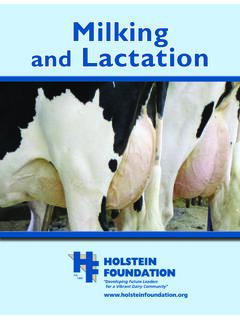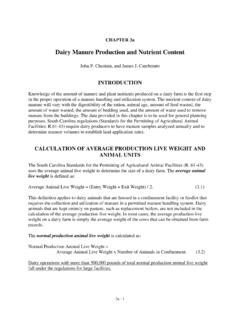Transcription of Dairy Cattle Feeding and Nutrition management
1 Developed withDairy Training CentreTraining Package for Dairy Extension WorkersDairy Cattle Feeding and Nutrition managementAugust, 20172 Part I Training manualPart II Training GuidelineDairy Cattle Feeding and Nutrition managementIPrefaceSNV Ethiopia, through EDGET project (Enhancing Dairy Sector Growth in Ethiopia, 2013-2018), engages in the capacity building, extension services and innovative support to the Ethiopian Dairy sector particularly working with smallholder Dairy farmers. The aim of the project is to increase milk production and productivity in order to double the income of the smallholder Dairy farmers. EDGET is operational in the regions Oromia, Amhara and SNNP, and working with 65,000 Dairy farming project works closely together with livestock regional bureaus and their respective zonal, woreda and kebele staff in delivering extension and other supports.
2 One area of collaboration is the development of practical training and coaching tools and materials for extension workers based on a need assessment. SNV has engaged the Netherlands based Dairy Training Centre (DTC) for the development of the Training package for extension workers. The documents were more elaborated and validated with the utmost contribution of high level experts from regional Livestock and Fisheries resources Development Bureaus/Agencies and Research Centers from the three operational regions of nine training packages were developed on Breed Improvement and Fertility management ; Dairy Cattle Feeding and Nutrition management ; Dairy Cattle Health management ; Dairy Farm management ; Dairy Housing and Manure management ; Farm Economics; Forage Production and management ; Hygienic and Quality Milk Production; Young Stock management .
3 This training package is on Dairy Cattle Feeding and Nutrition , also on behalf of the experts that contributed and DTC, would hope to see the materials widely used outside the project areas by all interested Dairy development practitioners. The materials will be available in hard copies and soft copies including on SNV website and other relevant of ContentsPreface .. IList of tables .. IVList of Figures .. VAbbreviations .. VII. Dairy Cattle Feeding and Nutrition management Training manual .. 11. Introduction .. 12. Dairy Cow Behavior and Impact on Dairy Cattle Nutrition management .. Dairy Cow Behavior .. Impact of behavior on Feeding management .
4 Digestive system of ruminants .. The foregut of the ruminant .. Digestion of carbohydrates, protein and fat in the fore stomachs .. composition of feedstuffs .. Water and dry matter .. Carbohydrates .. Fats .. Crude protein .. Inorganic matter or ash .. Summary of the composition of feedstuffs .. of the Feeding value of feedstuffs .. Methods used to analyze the Feeding value of feedstuffs .. The utilization of energy by a ruminant animal .. Energy evaluation systems .. Protein evaluation systems .. 126. Feed resources in Ethiopia and their characteristics .. Roughages .. Concentrates .. Comparing the quality of roughages and concentrates on dry matter basis.
5 167. Feed requirements for various categories of Dairy animals .. Energy and protein requirement for maintenance and lactation .. Feeding of dry and pregnant animals .. Feeding of milking cows in different stages of lactation .. Feeding of a cow during early lactation .. Feeding of a cow during mid and late lactation .. Mineral and vitamin requirements .. Which minerals are needed? .. Mineral requirements of Dairy Cattle .. General remarks regarding mineral supplementation .. Vitamins .. Water requirements .. Feeding guidelines for Dairy crossbred cows .. 25 III8. Feed Improvement and feed storage .. Urea-molasses straw treatment.
6 Multi-nutrient block preparation .. Feed storage .. Causes of feed spoilage and losses .. Proper feed handling and storage .. 329. Ration calculation .. Dry matter intake .. Steps to be taken in calculating and balancing a ration .. Supplementation and substitution .. Formulation of concentrate mixtures on the farm .. 3610. Planning for dry season Feeding .. 3911. Monitoring Dairy Cattle Nutrition management .. 39 References .. 41 Annex 1: List of common feedstuffs in the (sub) tropics and their nutritive value for Cattle .. 42II. Dairy Cattle Feeding and Nutrition management Training Guideline .. 47 A. Module Book ..48 B. Lesson matrix .. 53 C.
7 Checklist for monitoring Feeding management .. 61 D. Judgement results last milk production registration .. 63 E. Analysis of possible metabolic disorders .. 64 IVList of tablesTable 1:Maintenance requirements of adult cows per day .. 17 Table 2: Production requirements per kg of milk .. 18 Table 3: Maintenance and pregnancy requirements per day .. 20 Table 4: Function and deficiency signs of macro and micro elements .. 22 Table 5: Mineral requirements of Dairy Cattle .. 24 Table 6: Requirements for preparing urea treatment of straw .. 28 Table 7: Materials required for multi-nutrient block preparation .. 29 Table 8: Criteria Dairy Cattle Nutrition management .
8 39 VList of FiguresFigure 1: Enough feed and Feeding space ensures a high feed intake .. 3 Figure 2: Schematic representation of ruminant s digestive system .. 3 Figure 3: Rumen Papillae .. 4 Figure 4: Schematic representation of the fore stomachs .. 4 Figure 5: Damaged rumen papillae due to rumen acidosis .. 6 Figure 6: Composition of feedstuff .. 10 Figure 7: Naivasha Star grass pasture .. 14 Figure 8: Maize silage .. 14 Figure 9: Young, dark green (well fertilized) leafy Napier .. 15 Figure 10: Examples of multi-nutrient blocks .. 30 Figure 11: Three bags of napier (60 kg) is enough to feed 1 crossbread cow for 1 day .. 33 Figure 12: Concentrate supplementation during milking , maximum 2-3 kg.
9 35 VIAbbreviationsADF Acid Detergent FiberBCS Body Condition Scoring CF Crude FiberCP Crude ProteinDCP Digestible Crude Protein DM Dry Matter EE Ether ExtractIOM Inorganic Matter NDF Neutral Detergent Fiber NFC Non Fiber CarbohydratesNFE Nitrogen Free ExtractNPN Non-Protein Nitrogen NRC National Research Council OM Organic Matter TDN Total Digestible Nutrients1I. Dairy Cattle Feeding and Nutrition management Training manual1. Introduction Over the last decades an enormous amount of research has been done into the ways in which livestock use feed to maintain life, to grow, to reproduce and to produce all of the animal products which man uses, especially Ethiopia animal production is often a secondary activity within the subsistence farming system.
10 However, commercial Dairy farming in Ethiopia is expanding due to income increase, rapid urbanization and changing dietary habits. Dairy cows (and all other ruminants) have the capacity to convert roughages and other by- products from the human food industry, otherwise useless waste products, into valuable products like milk and meat. In this capacity as waste product utilizers ruminants contribute to the environment. However also negative impact from managing livestock is there. In Ethiopia overgrazing has caused land erosion and in 2007 the FAO calculated that the livestock sector contributes 18 % of all greenhouse gas emissions which lead to climate change.
